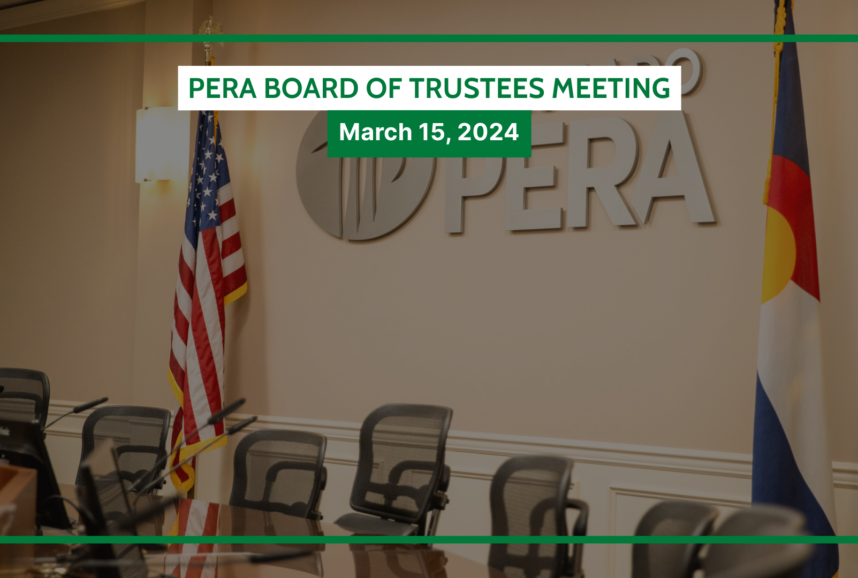As SB 18-200 makes its way through the Legislature, there has been significant discussion over the goal line: the 30-year timeframe in which PERA becomes fully funded. There has been debate over whether achieving full funding in 30 years is the right goal – some say it is too aggressive while others say it is not sufficiently so. Agreement on the goal is a critical part of the conversation, as the destination surely dictates the direction.
There are several reasons why the PERA Board of Trustees and many others are advocating for a 30-year goal, which is also referred to as an amortization period, and why it served as the basis for the Board’s recommendation to the General Assembly.
Full funding in 30 years is compliant with Colorado statute and the PERA Board’s policy. In 2015, the PERA Board of Trustees adopted The Colorado PERA Defined Benefit Plan Funding Policy to inform decisions on whether to seek legislative changes to benefits and contributions. Within the policy, the time frame to reach full funding is set at 30 years. This is reflective of the section of Colorado State statute that states, “A maximum amortization period of thirty years shall be deemed actuarially sound.”
Full funding in 30 years is achievable. Late last year, after many months of gathering input from stakeholders, the PERA Board finalized a legislative recommendation that would fully fund PERA within 30 years and was based on “shared responsibility” between members, retirees, and employers. These deliberations included months of internal debate, consultations with actuaries and other experts, an extensive in-person listening tour with stakeholders throughout Colorado led by PERA staff, and a series of telephone town hall meetings.
The Board’s recommendation includes a unique feature, the automatic adjustment provision that would allow PERA to remain on a path to full funding in 30 years without requiring additional legislation. The automatic adjustment mechanism would trigger modifications to contributions and the annual increase to ensure the 30-year goal is met.
Full funding in 30 years gives PERA resiliency. While 30 years may seem like a long time to pay down the unfunded liability, it is important to note that the plan will continue to get stronger over that period of time. Under the Board’s proposed 30-year plan, PERA’s funded status would improve as the unfunded liability decreases. This improvement would help the fund’s ability to withstand economic fluctuations and market corrections.
While it might seem enticing to extend the funding deadline to mitigate the effect on benefits and contributions, that path is not prudent fiscal pension policy. For example, the model of a 40-year amortization period shows that PERA’s funding levels remain flat for decades before finally turning upward. This means PERA’s unfunded liability will grow for decades before decreasing.
Full funding in 30 years is fair to all generations of public employees. The average service period for a PERA member is 23 years at retirement. If the length of time to pay off PERA’s unfunded liability were to be extended, it would also spread the cost of paying down the liability over a 40-year time period. In doing so, there would essentially be a transfer of cost to future generations who may well receive no benefit.
Full funding in 30 years helps the State’s credit rating. Standard & Poor’s has indicated the State’s credit outlook will be downgraded unless a plan to retire PERA’s unfunded liability is developed. Extending the period to pay down the unfunded liability to beyond 30 years does not meet the criteria stated by S&P. A credit rating downgrade would raise the cost of borrowing capital for the State and cost Colorado taxpayers.
While the PERA Board has no legislative authority, it does have expertise. The proposal offered by the Board last fall was intended to offer the foundation for the conversations that are underway now at the Capitol. But the fact that the bipartisan SB 200 was introduced with the 30-year funding timeline indicates that lawmakers agreed with the assessment of the PERA Board and its many expert consultants.
As the conversation surrounding the destination of SB 200 continues, the 30-year goal line should remain intact, reflecting the qualities of being sensible, equitable, and achievable.
Unfunded liabilityThe difference between the projected amount of money needed to pay benefits earned to date and the amount of money currently available to pay those benefits.Defined benefitAlso known as a pension, this is a type of pooled retirement plan in which the plan promises to pay a lifetime benefit to the employee at retirement. The plan manages investments on behalf of members, and the retirement benefit is based on factors such as age at retirement, years of employment and salary history.AmortizationThe act of paying down debt or liabilities over time.





I’m a PERA retiree of 12 years who is fed up with hearing about “shared responsibility”. I was promised a 3.5% annual increase, it was contract, there was no mention that “maybe later this will be reduced”. Yet you quickly reduced that amount to around 2% in a “good”year, and with no guarantee of ANY increase if things aren’t so good. Fairly certain it wouldn’t have been acceptable for me to have decided you weren’t paying a fair wage and therefore only work six hours a day instead of eight… eight was the contract and eight it was. So, why was that contract binding and enforced, but not the one for my retirement? And now I’m being asked to further “share” the burden… hell NO, we had a deal, and I’m still bleeding from the first gash.
Many who retired with this 3.5% guarantee were in lower paying service jobs, the increases were depended upon by these hard working 20 and 30 year career employees just to live a meager lifestyle after retirement, this already breached contract surely has pushed many of them below the poverty line, now you want to squeeze them further??? Take it from Judicial and state police and their eternal sweetheart deals, it’s outrageous that these very well paid positions get even more in retirement than those who actually need it. That bit is shamelessly self-serving and needs to go.
As inflation heats up PERA retirees will begin to suffer especially with the 2 or 3 year moratorium on any increase and then the even further reduction of increases. I am heartened by the beginnings of a teacher rebellion over wages. Its now time for retirees to organize and flex our political capital to demand that PERA and the state hold up their end of the contract.
I can’t believe you’re doing it again! This is another breach of contract!
I agree with Mr. Driver. I spent 9 years with the county in a Sheriff’s Department and the 20 years with DOC. County retirement sucked and all that the state offered was a hollow promise with step increases in salaries, benefits, matching 401 contributions and retirement for some of us with the rule of 80; for which I qualified. Now after serving all that I have heard is PERA this and PERA that and the members are stuck with the bill with the bumbling legislators on the front range. I only wish that those of us on the west slope had more votes to counter all the politics on the front range! My wife, also a PERA/DOC retiree has an idea that Colorado should enter into the electoral process with each count having one and only one vote on government matters. Makes sense to me! Oh, an afterthought, Greed rules!
Please negotiate for full social security benefits. As an educator, I worked multiple jobs to earn a reasonable living. However, I cannot receive my full social security benefit due to our pension even though I had to pay in through my employers. If we could get this full benefit, it would help many fill the gap in the reduced COLA benefits.
I realize the angst many PERA retirees feel, but I know what it is like to have to adjust to revenue adjustments in the public and private sectors. My only career has not been teaching with a wonderful retirement plan. I wish there was some way to give those retirees over 70 years old who taught over 25 years, but receive less than $1500 a month an increase. The variables in setting funding goals include the stock and bond markets, longevity of retirees, and the willingness of the taxpayers to continue our very good retirement plan through their respective school districts. I started teaching in 1966 in Kersey, CO for $4600. I retired in Littleton Public Schools with and EdD at $85000. I had a fifteen year hiatus from teaching during which I worked in the private sector and paid into Social Security. Thus, I receive a small monthly social security stipend. I am grateful for the money I paid into PERA growing as well as it has over the twenty-six years I contributed. Therefore, I support the adjustments that need to be made.